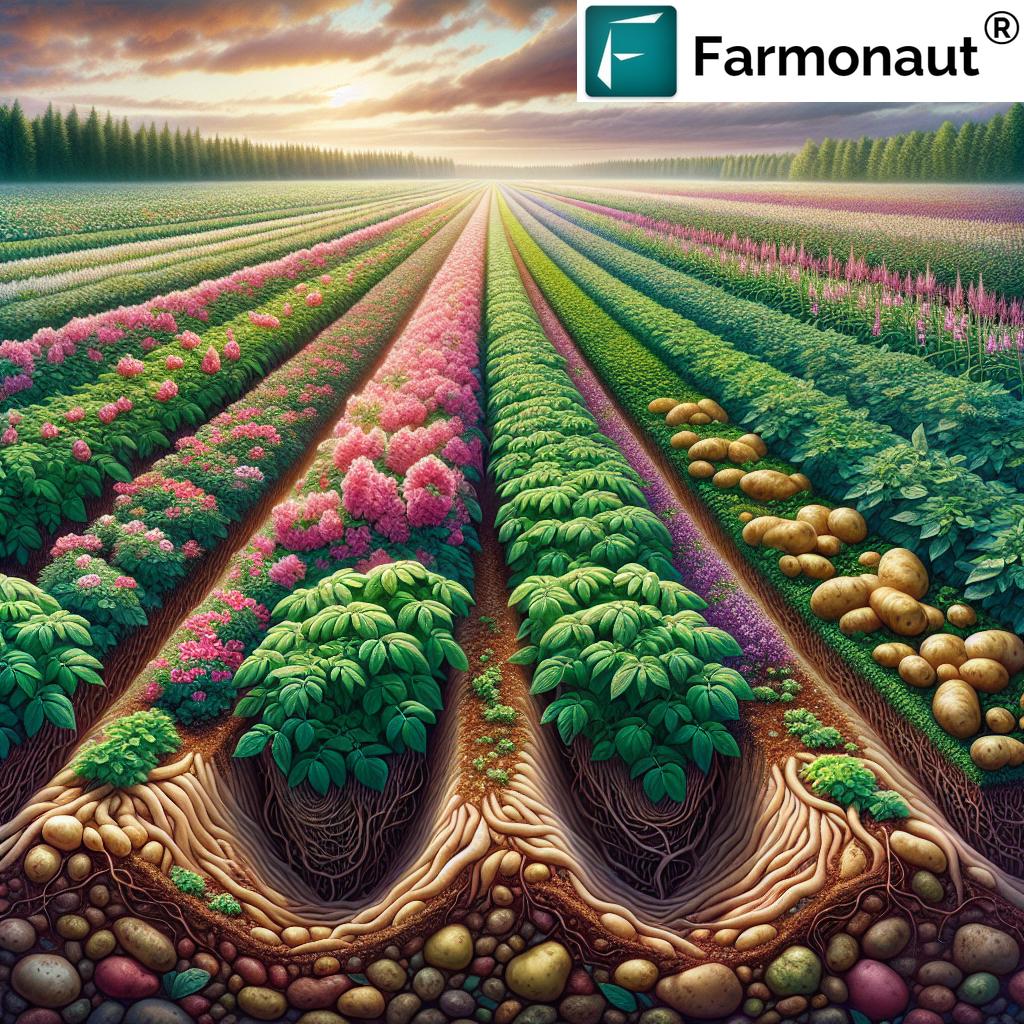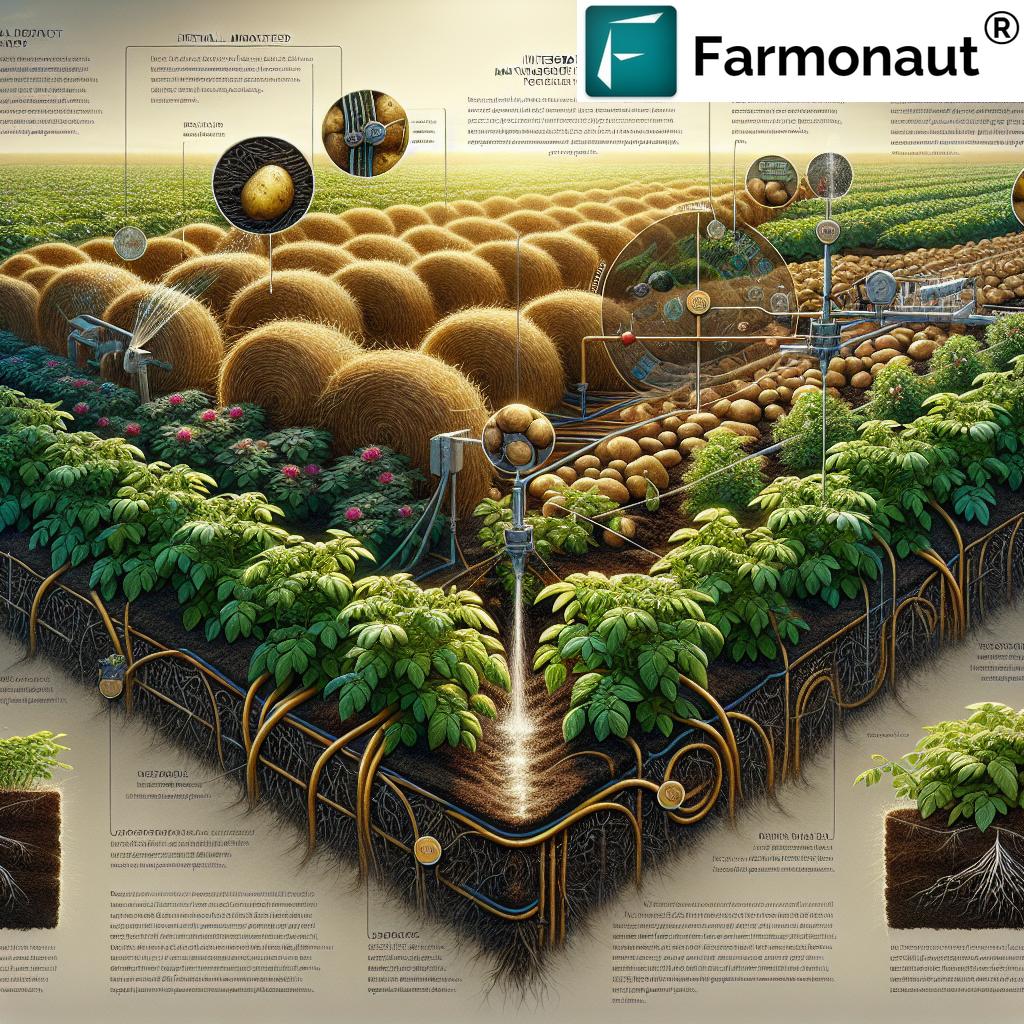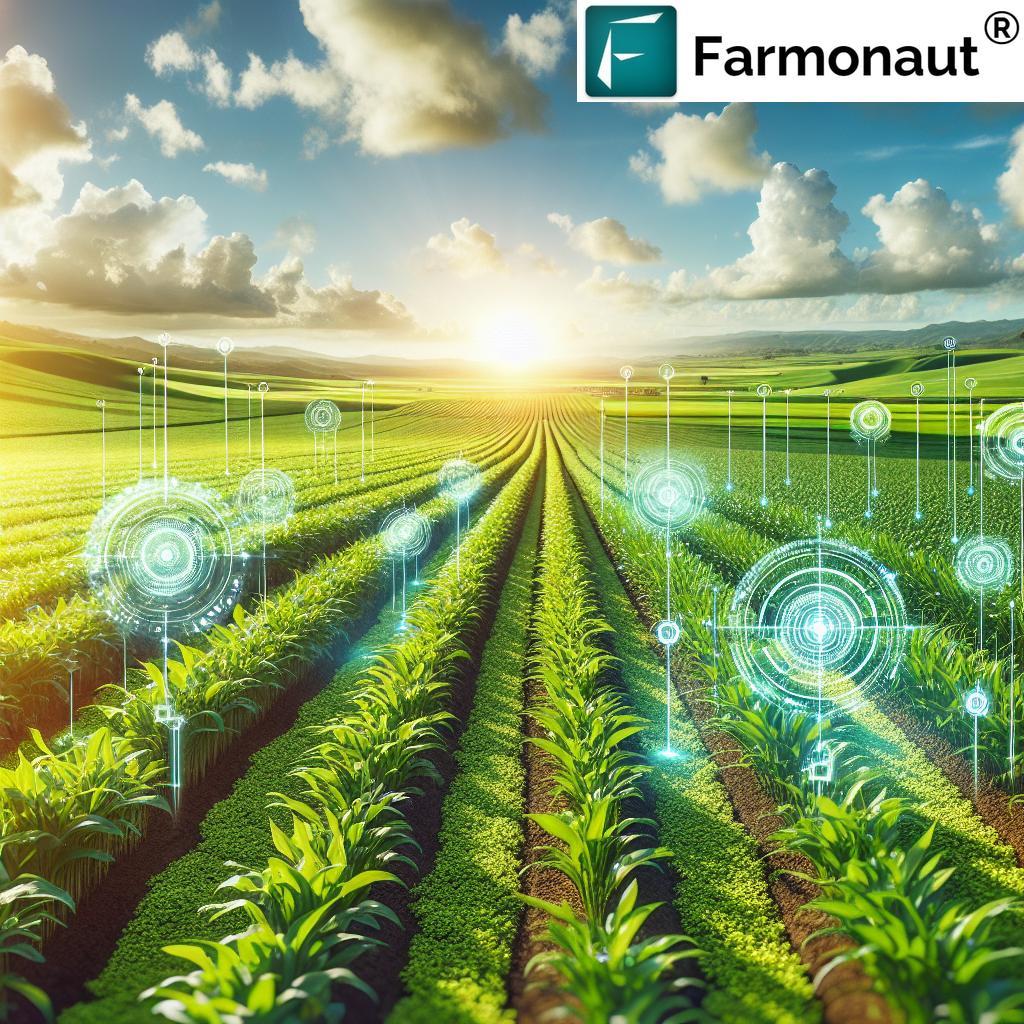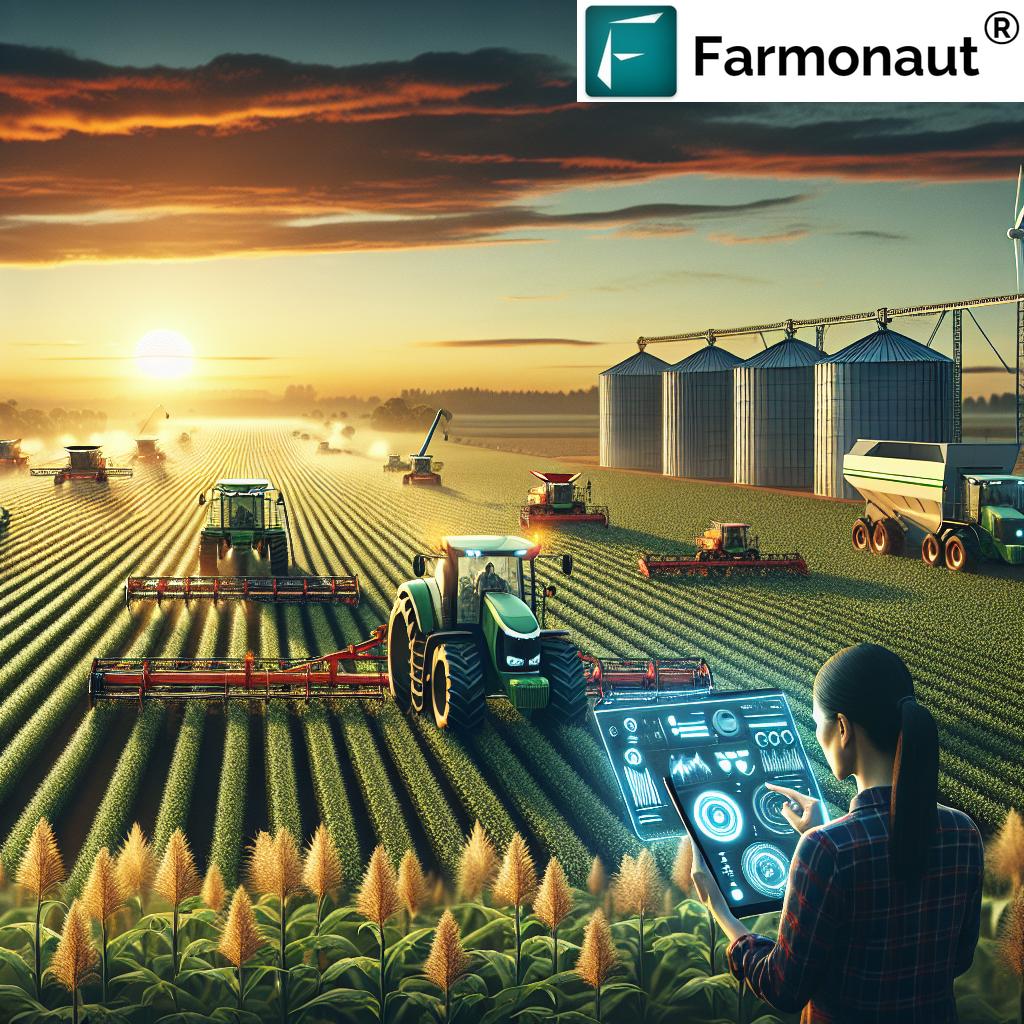Sustainably Grown Potatoes: 7 Shocking Farming Secrets
Table of Contents
- Introduction to Sustainable Potato Farming
- Trivia: Did You Know?
- 1. Soil Health Management in Potatoes
- 2. Efficient Irrigation for Potato Crops
- 3. Integrated Pest Management for Potatoes
- 4. Energy Efficient Farming Techniques
- 5. Biodiversity in Potato Cultivation
- 6. Certification Programs & Industry Initiatives
- 7. Technological Innovations in Sustainable Potato Farming
- Comparison Table: Traditional vs. Sustainable Potato Farming
- Economics of Sustainable Potato Farming
- Farmonaut Subscriptions
- Frequently Asked Questions
- Conclusion
“Sustainable potato farming can reduce water usage by up to 30% through efficient irrigation techniques.”
As the global demand for sustainably grown potatoes surges, more of us are looking for ways to boost yield while caring for our soil, water, and the planet. Sustainable potato farming offers an agricultural approach that strikes the perfect balance between food production and environmental responsibility.
By implementing innovative methods—from soil health management in potatoes and smart irrigation systems to advanced integrated pest management—we can cultivate potato crops that are not only high-yield and profitable but also support ecological sustainability. In this deep dive, we’ll unveil seven farming secrets that every grower, agtech enthusiast, and sustainability advocate should know. Join us as we reveal how you can minimize resource usage, strengthen farm resilience, and reduce your agricultural carbon footprint.
1. Soil Health Management in Potatoes: The Foundation of Sustainability
Sustainable potato farming starts with healthy soils. When we maintain soil health, we enhance nutrient availability, improve water retention, and support the activity of beneficial microbial organisms. Let’s break down the key soil health management techniques and explore their remarkable impact.
a) Potato Crop Rotation Practices and Diversification
One of the most vital practices is crop rotation. By alternating potato crops with legumes, cereals, or other non-host crops, we effectively:
- Break disease and pest cycles: Reduces buildup of pests and soil-borne diseases.
- Minimize nutrient depletion: Different crops draw different nutrients, preventing depletion and enhancing biodiversity.
- Enhance soil fertility: Legumes, for example, fix nitrogen in the soil.
Crop rotation is particularly crucial in regions with recurring potato cyst nematode or annual late blight outbreaks.
Read more about crop rotation for potatoes
b) Organic Potato Farming Methods: Compost, Manure & Green Cover
Embracing organic potato farming methods strengthens soil structure and increases microbial activity. Applying:
- Compost: Adds organic matter and slowly releases nutrients.
- Green manure: Incorporating cover crops to replenish nutrients.
- Animal manure: Improves soil health, moisture, and supports beneficial organisms.
Sustainable potato farming isn’t just about reducing chemical usage, but about building resilience in the farming system.
Learn more about organic potato farming techniques
c) Reduced or Conservation Tillage
Traditional, deep tillage can cause erosion and disrupt vital soil structure. In contrast, reduced tillage practices such as strip-tillage and mulching:
- Preserve organic matter and biodiversity
- Reduce fuel consumption and labor costs
- Minimize erosion by protecting topsoil
- Maintain soil moisture retention for better crop yields
Soil health management in potatoes is the bedrock of both environmental conservation and sustainable yield.
Explore reduced tillage practices for potatoes
2. Efficient Irrigation for Potato Crops — Saving Every Drop
Water is life—for people and potatoes. As water scarcity escalates globally, efficient irrigation for potato crops becomes the linchpin of sustainable food production. How can we optimize water usage for maximum crop benefit while reducing environmental impact?
-
Drip Irrigation Systems: This method delivers water directly to plant roots, drastically minimizing evaporation, runoff, and waste. This precision ensures each potato receives exactly what it needs—no more, no less.
How drip irrigation supports sustainable potato farming -
Rainwater Harvesting: By collecting and storing rainwater during wet seasons, farms reduce their reliance on groundwater or municipal water systems. This promotes water conservation and ensures a backup for dry spells.
Discover rainwater harvesting in India’s potato farms -
Climate-Smart Irrigation Scheduling: Employing computer models and real-time soil moisture monitoring allows for precise watering based on actual weather conditions and crop needs. Farmonaut’s satellite-based platform provides AI-powered crop health monitoring and irrigation recommendations, ensuring that not a single drop is wasted!
Wisconsin’s steps for optimal potato irrigation
The result? Efficient irrigation for potato crops cuts water use by up to 30%, preserves freshwater resources, and reduces input costs.
3. Integrated Pest Management for Potatoes — Smart Ways to Control Pests
The threat from pests and diseases in potato cultivation is real and ever-present. However, using a chemical-intensive approach is increasingly unsustainable. Integrated pest management for potatoes (IPM) combines biological, cultural, physical, and chemical methods to provide lasting pest control while protecting soil and biodiversity.
Key Components of Potato IPM
- Biological Controls: Introducing natural predators or beneficial insects (like ladybugs or nematode-killing bacteria) keeps pest populations in check.
- Cultural Practices: Crop rotation, field cleanliness, and planting resistant potato varieties can disrupt pest life cycles and reduce outbreaks.
- Physical Controls: Using traps, physical barriers, and even manual removal of infested plants to lower pest numbers without chemicals.
-
Chemical Controls: When absolutely necessary, we apply the lowest-impact, targeted chemical pesticides, always as a last resort.
Read about reduced pesticide use in sustainable potato farming
Integrated pest management for potatoes decreases overall chemical input by 40%, keeping both soils healthy and potato-growing communities safe.
“Integrated pest management in potatoes lowers chemical pesticide use by nearly 40%, protecting soil and biodiversity.”
4. Energy Efficient Farming Techniques: Reducing Carbon Footprint in Agriculture
Achieving sustainability is not just about what we put into the soil, but how we run our farm operations. Traditional farming methods can result in significant fuel consumption and greenhouse gas emissions. The future? Energy efficient farming techniques and a focus on reducing the carbon footprint in agriculture.
Energy-Smart Strategies in Potato Farms
- Adopting Renewable Energy: Powering irrigation and storage with solar panels or wind turbines cuts fossil fuel reliance.
- Modern Machinery: Energy-efficient tractors and equipment reduce fuel costs, input use, and emission per kg of potatoes grown.
- Minimized Tillage: Less plowing means less fuel burned, less carbon lost from the soil, and more soil structure preserved.
Reducing carbon footprint in agriculture starts with smart management. With tools like Farmonaut’s Carbon Footprinting Service, growers can monitor in real-time their environmental impact, enabling smarter, greener farming decisions — and meeting both regulatory and market sustainability standards.
5. Biodiversity in Potato Cultivation — Nature’s Insurance Policy
A monoculture farm is vulnerable. But when we promote biodiversity in potato cultivation, we efficiently protect our crops, soil, and farm ecosystems.
- Habitat Enhancement: Planting cover crops, installing wildflower strips, and preserving hedgerows create safe havens for pollinators and natural pest enemies.
- Diverse Rotations: Alternating potatoes with various crops (legumes, cereals, oilseeds) supports a richer soil microbe community, helping to suppress diseases and improve nutrient cycling.
- Reduced Chemical Use: Enhanced biodiversity improves natural pest control and reduces our dependence on chemical products.
Biodiversity makes farms more resilient to climate shocks, pest infestations, and market fluctuations. It’s a key aspect of sustainable potato farming, safeguarding food security for generations.
6. Certification Programs and Industry Initiatives for Sustainable Potato Cultivation
Validation of sustainable practices fosters market trust, ensures industry accountability, and can open new commercial opportunities.
- Healthy Grown Certification: The Healthy Grown program provides an eco-label identifying potatoes produced with IPM and conservation practices. This assures consumers of your environmental responsibility.
- Potato Sustainability Alliance (PSA): The PSA links growers, businesses, and organizations in developing and promoting sustainable potato farming practices globally.
These certification programs elevate standards across the sector, foster innovation, and promote responsible production in local and international markets.
7. Technological Innovations in Sustainable Potato Farming
Modern sustainability is data-driven! With advancements in precision agriculture and farm management software for agriculture, even the smallest potato farm can harness satellite technology and artificial intelligence for smarter resource optimization.
- Satellite-Based Crop Health Monitoring: Systems like Farmonaut’s satellite imagery tools monitor potato crop health (NDVI), soil moisture, and pest hotspots—delivering actionable insights without expensive hardware.
- AI-Driven Jeevn Advisory: Powered by real-time data, this tool delivers precision advice on irrigation, fertilization, and pest management, boosting yields while reducing input waste.
- Farm Management Platform: Through user-friendly web and mobile apps, growers can plan, monitor, and analyze farming operations, ensuring sustainability every step of the way.
- Fleet and Resource Management: Large farms can leverage Farmonaut’s fleet management tools to boost operational efficiency, improve logistics, and lower costs.
-
API Integrations: Developers and businesses can incorporate satellite and weather data directly into their workflows via the Farmonaut API
(developer docs).
Embrace these technological innovations to reduce wastage, save resources, and protect the environment—all while enhancing farm profitability.
For large enterprises and government agencies, Farmonaut’s Large-Scale Farm Management Suite streamlines decision-making in plantations and multi-farm operations.
Comparison Table: Sustainable vs. Traditional Potato Farming Methods
| Farming Practice | Traditional Method | Sustainable Method | Estimated Yield Increase (%) | Estimated Carbon Footprint Reduction (%) |
|---|---|---|---|---|
| Soil Health Management | Monoculture, heavy synthetic inputs, deep tillage | Crop rotation, organic fertilizers, reduced tillage | 10-15% | 20-35% |
| Irrigation Efficiency | Flood or overhead irrigation, minimal scheduling | Drip systems, rainwater harvesting, digital scheduling | 5-12% | 20-30% |
| Pest Management | Frequent broad-spectrum chemical pesticides | Integrated pest management (IPM), targeted/organic controls | 5-10% | 35-45% |
| Energy Use | Diesel-powered machinery, no renewable sources | Energy-efficient equipment, renewables, minimal tillage | 4-8% | 25-40% |
| Biodiversity | Monoculture, minimal habitat creation | Crop/livestock diversity, cover crops, habitat conservation | 5-9% | 20-28% |
Data reflects industry averages and research insights; local results may vary.
Economics of Sustainable Potato Farming: Cost, Profit, and Market Access
Sustainable potato farming isn’t just about ‘going green’. It pays dividends on the balance sheet as well:
- Input Cost Savings: Lower usage of synthetic fertilizers, pesticides, and water reduces expenses.
- Market Premiums: Certified sustainable potatoes often fetch premium prices and provide access to discerning retail and export markets.
- Resilience to Shocks: Diversified fields and improved soil health buffer against climate stress and price swings.
- Financing & Insurance: Tools like satellite-verified crop loan & insurance access help sustainable farmers secure financial products with ease and transparency.
By investing in resource efficiency now, potato growers can drive profitability and viability for decades to come.
Did you know? Farmonaut enables crop loan and insurance verification via satellite, making it easier for farmers to prove farm activity, minimize fraud, and access needed credit.
Choose Your Farmonaut Subscription — Start Your Sustainable Journey
Frequently Asked Questions: Sustainable Potato Farming
What is sustainable potato farming?
Sustainable potato farming balances high-yield food production with stewardship of soil health, water efficiency, pest management, and reducing the carbon footprint. It focuses on long-term farm viability and environmental protection.
How can I start improving soil health in my potato field?
Begin by practicing crop rotation with legumes or cereals, incorporating organic compost or green manure, and reducing deep tillage to preserve soil structure. Farmonaut’s satellite-based tools can help you monitor soil health and make data-driven interventions.
Are technological solutions affordable for small farms?
Yes. Cloud-based, satellite-driven platforms like Farmonaut provide precision data and advisory support via web and mobile apps, making modern precision agriculture accessible to farms of all sizes, without hefty hardware investments.
Which app or software will help manage sustainable practices?
Farmonaut’s multi-platform suite enables crop, soil, and resource management via satellite imagery, AI-powered recommendations, and blockchain traceability. It’s available on web, Android, and iOS.
What support exists for sustainable potato farmers?
Joining potato sustainability initiatives and industry groups, pursuing certification (like Healthy Grown), and accessing data-driven tech (Farmonaut) provides support, networking, and market advantage.
How can sustainable farming affect my profits?
Sustainable practices often lower input and energy costs, increase yield resilience, and enable access to premium or export markets, supporting both short-term profitability and long-term economic sustainability.
Conclusion: Harvesting the Future, Sustainably
In summary, sustainably grown potatoes are no longer a dream—they are a reality achieved through the deliberate implementation of cutting-edge, environmentally friendly potato farming practices. From rebuilding soil fertility to harnessing water conservation techniques and smart technologies, we can reduce our carbon footprint while ensuring resilient, profitable farms for years to come.
With platforms like Farmonaut—offering real-time monitoring, resource and fleet management, product traceability, and carbon footprinting—we empower potato farmers everywhere to balance food production with sustainability, all while increasing transparency, efficiency, and profitability.
Now is the time to adopt sustainable potato farming methods. Together, let’s conserve our resources, protect the environment, and grow potatoes that nourish both people and planet.
Ready to start your sustainable potato journey?
- Try the Farmonaut web/mobile app today or explore our API for seamless integration.
- For plantation growers and commercial operators, discover the enterprise and large-scale farm management suite.
It’s time to farm smarter, not harder—because the future is sustainability.

















